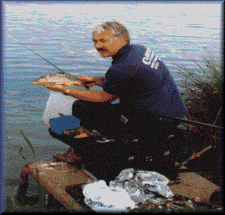|
|

Home
LINKS
My Autobiography

Special Offer eBook
Home
Fishing-Media co uk

Gold Medal Floats
Welsh
Record Fish Weights
World Championship
Tables
My Story
My Angling Tips
My Tuition
Belmont on Wye
Fishing Venue Guide
Wales
Fishing eBooks
Clive Branson's
Coarse fishing
Ebook
Angling-News
ARCHIVES

eBook Series
New Angling-News
T Shirt Gift Shop

Fishing Guide Wales
on CD eBook
Click Here
Subscribe to My Tips
 |
Tips..
1.
A cheap alternative to pole float winder anchors. Use any left over pole elastic, just a few inches and tie a loop either end and use as a cheap alternative to expensive pole winder anchors. Simply loop one end to line and the other to the winder.
2.
Small drip feeder cup. When fishing the pole and want a small drip of feed going into the swim. Use a plastic kinder egg container bought from a local sweet shop. Simply make a hole either end of the cup ready to slip onto the end of the Pole. Before doing so, either make a few holes so that maggots can crawl out and drop into the swim. Alternatively cut a hole large enough for feed to drop out when shaking the pole. The plastic kinder egg can split in the middle for filling.
3.
Keeping hooks rust free. Simply drop a few rice seeds into the hook box. The rice will absorb any moister present. Change the rice when needed.
4.
Hook traces. It is so much easier when changing hook lengths to have them made up on a readymade trace. Tie them up at home and lay them on a rigid card, 10 inches by 8 inches. Use either a cereal package or cut a piece from a cardboard box. Simply cut a groove either end and attach the hook to one end and loop the other and attach. Mark the size of hook and breaking strain with a pen on the card next to the trace.
5.
Keeps hook sharpened. A small emery cloth 2 inches by 2inches kept in the tackle box is an ideal hook sharpener. Alternatively use a small sharpening stone and with a few gentle rubs along the point of the hook will keep them sharpened. Especially when hooking the bottom of a stone based waterway.
6.
Hooking more fish. By turning the hook slightly outwards and to the side will allow the point of the hook to penetrate a fishes mouth much easier allowing more hooked fish when striking.
7.
Easy joints. Use candle wax on joints of the pole or rods, This will help to protect the joints as well as making them slip easier together or apart.
8.
Stop line freezing in rod eyes. When winter fishing use a dab of glycerine to each eye on the fishing rod. This will stop the eyes from freezing up in cold winter conditions.
9.
Loading line on to reels. When loading line onto a fishing reel, place the new spool of line into a container of water (small bucket or sink will do) attach new line to reel either by a loop or tie onto backing line. Manually whip a few loops of line around the knot before reeling on new line. The water in the container will clean the line as well as loading the reel spool correctly without twisting.
10
Disposing of line. Cut up old or discarded line with a pair of scissors, into small one inch pieces before disposal.
11
Pole Cups. Use tops of old canisterís as pole cups. Either fix to end of spare pole top or Glue a small spring attachment to bottom of the top. Fix to pole as a cheap alternative to a pole cup. Available in small sizes.
12.
Unhooking eels. Hold an eel upside down with the use of the top of the keep net or landing net. This will subdue the eel whilst holding the wriggling eel still. Use a stompo disgorger for deep swallowed hooks.
13.
Swimfeeders. Use plastic hair curlers as a cheep alternative. Simply apply a small strip of lead to the side and attach a swivel to the top.
14.
Mini feeder. Use a strip of thick cellophane such as an x-ray sheet. Roll into a small cone. Attach a swivel to the top and swan shott in the top of the cone. A cheap and ideal mini groundbait feeder.
15.
Plummet for snaggy bottoms. Roll a flat piece of lead around a strip of sponge and flatten. Pass the hook through the sponge. Use as a plummet. If the plummet gets stuck on the bottom simply apply pressure. The float rig will come away all in tact. A convenient and cheap way of not loosing the float rig in a snaggy swim.
16.
Camouflaging a float. Simply paint the body of a float white. This will camouflage the float against a bright sky. Allowing shy feeding fish to feed under the float
17.
Degrease fishing line. Place the fishing reel spool in a tub of water, add washing up liquid and leave to soak over night. This will degrease the fishing line and allow the line to sink. Ideal when waggler or ledger fishing.
18.
Floating line. Use a flat piece of cloth dipped in Vaseline. Cast the line out and retrieve holding the cloth so that the line runs between pinched fingers. Alternatively purchase musclin from tackle shop and apply the same. Ideal for stick float fishing.
19.
Hooking worms. Break the worm in half and hook the two pieces on the top. This will allow the juices to leak from the bottom of the worm whilst the natural wriggle will attract those feeding fish.
20.
Hooking maggots. Hook a maggot from underneath the two eyes. This will allow the hook to face upwards so not to snag on the bottom. Whilst lifting up when striking into a fish.
21.
Double maggot hooking. Top and tail the maggot when using double maggot. This will help stop twisting of line when retrieving.
